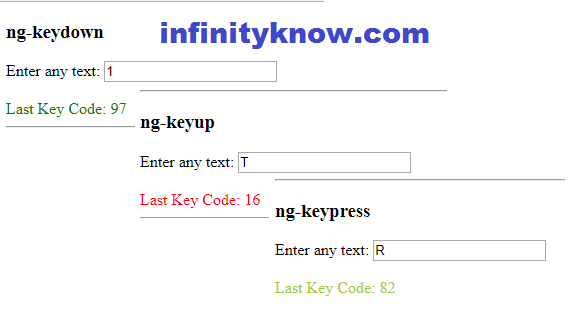

Now, consider a different example demonstrating the effect of keyup() method. After the pressed key is released, the background color of the input field changes to teal as shown below.

The keyup event occurs once a key is released, which in turn makes the keyup() method to execute the attached function.The reason behind this color change is that the jQuery keyup() method attaches a function to the selected input box as soon as the keyup event is triggered on releasing the key.Now, as we press any key and release it, the background color of the input box changes to coral as shown in the screenshot below.At this point, the background color of the text field is white with no input provided.The below screen gets displayed when the page is first loaded in the browser.Width: 400px height: 300px padding: 20px font-size: medium margin: auto īorder: 3px solid cornflowerblue background: lightgray Įxample for jQuery keyup event Enter any value: Įnter anything in the text box, and the background color will change on key up. $("input:text").css("background-color", "yellow") $("input:text").css("background-color", "coral") This example is the illustration of the working of the keyup() method. Given below are the examples mentioned : Example #1 keyup: Event is triggered, that is, each time a key is released.function : It is an optional parameter that specifies a function to be executed each time.selector: It is the selected HTML element.To attach a handler/function to the keyup event. To trigger the keyup event for the selected element. keyup(): This method detects if the key is released.keypress(): This method detects if the key is pressed down.keydown(): This method can find out if a key is on its way down.This may be the empty string if the browser or device doesn't know the keyboard's locale. Returns a string representing a locale string indicating the locale the keyboard is configured for.

Returns a string representing the key value of the key represented by the event. Returns a boolean value that is true if the event is fired between after compositionstart and before compositionend.

Returns a boolean value that is true if the Ctrl key was active when the key event was generated. If you want to display the correct keystrokes to the user, you can use Keyboard.getLayoutMap(). Warning: This ignores the user's keyboard layout, so that if the user presses the key at the "Y" position in a QWERTY keyboard layout (near the middle of the row above the home row), this will always return "KeyY", even if the user has a QWERTZ keyboard (which would mean the user expects a "Z" and all the other properties would indicate a "Z") or a Dvorak keyboard layout (where the user would expect an "F"). Non-standard MSManipulationStateChanged.Non-standard Deprecated MozMousePixelScroll.Non-standard Deprecated createShadowRoot().


 0 kommentar(er)
0 kommentar(er)
